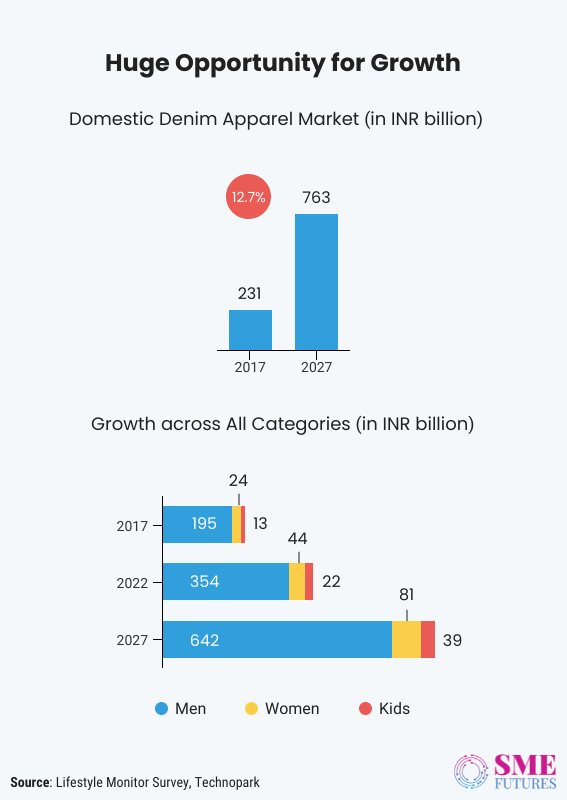When it comes to textiles, denim has always reigned supreme. It is a popular fabric among fashion designers and is widely used in accessories as well. As a result, the Indian denim market has evolved dramatically over the years.
Vinay Thadani, CFO at Vishal Fabrics, one of India’s largest denim fabric makers, tells SME Futures that denim usage in India is driven by rapid urbanisation, rising disposable incomes, increasing fashion consciousness among consumers, a surge in the penetration of fashion brands, and the significant growth of the country’s retail sector and e-commerce. Thadani believes that the denim fabric market has a lot more room to grow and says that the next wave of demand for denim will arise from the Indian hinterlands.
Simultaneously, he also discusses his company’s performance and their future plans with us.
Edited excerpts:
Take us through the journey of Vishal Fabrics briefly and elaborate on how being based in Gujarat benefits your company.
Vishal Fabrics Limited (VFL) is India’s largest denim fabric manufacturer and fabric processor. We began in 1985, with a dyeing and processing capacity of 105 million metres per annum (MMPA). In 2014, we initiated expansion with denim fabric manufacturing and processing at an output of 80 MMPA, with the goal of establishing around 8 assembly lines. This project was commercialised in 2016 with the introduction of two denim fabric assembly lines. By 2018, we had accomplished the commercial operation of eight lines.
As a satellite model, we develop fabrics, manufacture them, and sell them directly, while also fulfilling fabric manufacturing orders for other textile companies. Every month, we offer a diverse range of products in over 30 different designs. We are associated with a number of fashion brands such as Emporio-Armani, H&M, Lee, Levis, Zara, and others. In terms of current market capitalisation, we are worth Rs 644.87 crores. The company reported gross sales of Rs 1296.84 crores and a total income of Rs 1299.15 crores in the most recent quarter.
Being based in Ahmedabad is undeniably advantageous for us, as Gujarat is India’s textile hub. Furthermore, cotton is abundantly produced here, besides Maharashtra. And, because cotton is the raw material for denim, it is the best location for denim manufacturing. In addition, we benefit from the government’s good textile policy framework, which is in place to encourage the textile industries.
What is the current landscape of the denim fabric market in India and how is it growing at the moment?
Denim has grown in popularity among consumers over the years due to its versatility. People in the metros and tier 1 cities were the first to adopt it, but it is now widely used in Indian households in the tier 2, 3, and even in the tier 4 cities. As a result, the Indian denim market is a well-developed industry that has evolved significantly.
According to market insights, the global denim fabric market will grow at a 4.6 per cent annual rate from $87 billion in 2016 to $130 billion in 2021. When it comes to denim fabric, India ranks second only to China in terms of installed capacity. Domestic consumption of denim fabric is 800 MMPA, while exports are 200 MMPA. In terms of market value, it was Rs 231 billion in 2017, with the sector expected to be worth Rs 763 billion by 2027, growing at a 12.7 percent annual rate.

At this rate, I believe that there is a lot more room for expansion. Furthermore, denim is still considered as occasional wear fabric in many regions of India. In terms of denim jeans per capita consumption, India lags behind other regions such as Columbia and Mexico, where the average pair of jeans per capita is 9 and 8, respectively. In India, the number is three. Hence, our mission is to make it a daily wear fabric for a majority of the country’s population.

We also anticipate denim adaptability in rural India by 2025. However, we have no idea about how much denim demand will come from the rural areas. Nonetheless, we remain optimistic and are working towards it.
How has COVID-19 impacted Vishal Fabrics?
With all of the uncertainties surrounding COVID-19, we initially halted production for at least 10 days. However, we were back to manufacturing with all the necessary precautions and safety protocols in place. We also provide accommodation to our employees, so COVID-19 had little impact on our operations. However, our sales and marketing team has been in constant touch with our customers across the country and is well-positioned to tap the opportunities that will come our way post the lockdown. Besides being a difficult year for the sector, in FY21 we managed to clock Rs 968 crores.
On the bright side, we did learn from the pandemic because it forced industries to change, and we did as well. For starters, prior to COVID, we were primarily a domestic company, but we have since broadened our marketing portfolio. As a result of the new market regime, we are now dominant in the domestic market, catering to e-commerce houses. Furthermore, we expanded our operations to the international market and increased our export portfolio. As a result, our capacity is being better utilised. This, in turn, has increased our output (2.5 lakh metres) in comparison to what we were producing previously.
So, in my opinion, these are the changes that we have implemented, something that we were not thinking of doing prior to the occurrence of the pandemic.
Industries are prioritising sustainability goals. What steps has Vishal Fabrics taken to achieve this goal?
Sustainable and environment friendly solutions are the top call for the textile industry, as this sector is one of the major pollutant releasing industries. The top players in the industry are achieving sustainability in their products by producing textiles made from natural recyclable materials. Vishal Fabrics is also constantly working to implement environmentally friendly solutions on our shop floors and in our operations.
Let me give you an example, the company uses a go green washing machine for sampling and development. Besides that, we use water spray technology for washing fabrics in the making, which saves ~803 KL water per year. In a nutshell, our manufacturing plant is a zero-water discharge plant, utilising 100 per cent of the water used in the manufacturing and is disposed of properly. We have facilities in place to treat the water that is used.
Similarly, eco-friendly dyes are used instead of chemical dyes by the company. Our other initiative is to install a green belt around our facilities. VFL has already installed a massive green cover at the sites of both our plants (Narol and Dhodi) and our industrial park as well in an effort to preserve, enhance, and promote green spaces. We are working to implement green energy solutions in the future. This initiative will save money while also assisting us in meeting our sustainability goals.
What is your take on the PLI scheme for textile manufacturing?
The PLI scheme is intended to incentivise 14 different types of technical and man-made fibres (MMF). It will boost the manufacturing and production of yarns, which are currently dependent on other regions, such as China, for Indian textile players. A few types of manmade yarn and fibres are entirely imported from there. As a result of the PLI scheme’s benefits, this reliance will be reduced. Overall, it’s a great step forward for the Indian textile industry.
However, we are in the denim industry, and we use cotton yarn as a raw material. As a result, we are not covered by the PLI scheme. We are still awaiting detailed notifications about this and are seeking further information about the eligibility criteria.
What is your roadmap for the company down the line?
As I previously stated, we are aggressively expanding our footprint and had added 12 countries to our export portfolio by FY20. These are primarily South Asian nations. Moving forward, we are currently working on expanding to the Latin American and European countries, with a few more geographies to be added in the coming years. In addition, we will concentrate on increasing the share of our value-added products from 50 to 60 per cent, which meets the needs of a changing market. The company is also eyeing a rise in revenue share from our exports.
Furthermore, improving capability utilisation will remain a top priority for us. Going forward, we will add 25 per cent of our current infrastructure capacity, 50 per cent of which will be placed in this fiscal year and the remaining 50 per cent in the following fiscal year.
Vishal Fabrics’ other goal is to be debt-free by 2023. We have set a target of Rs 40 crores for this fiscal year, and we hope to be debt-free by the end of the next year.











